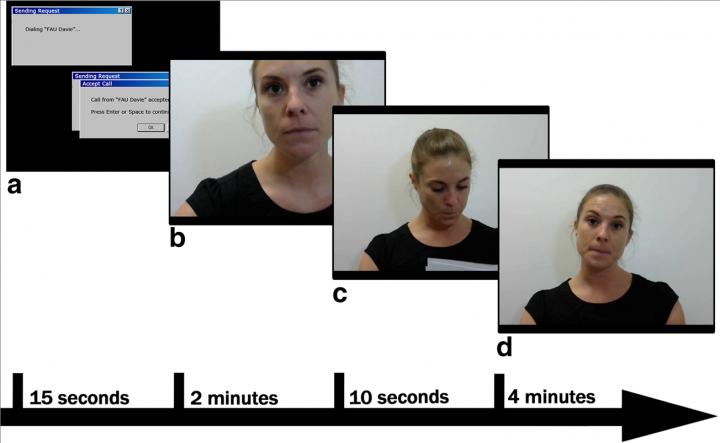Social distancing across the globe due to the coronavirus (COVID-19) is cajoling and even forcing businesses to use tools like Zoom, Skype, web conferencing and FaceTime, to remain virtually connected.
But are all forms of online communication alike? The question arises since sometimes people communicate with both cameras on. At other times, only the speaker may be visible.
Neuroscientists from Florida Atlantic University (FAU) demonstrated that a person’s gaze is altered during telecommunication if they think that the person on the other end of the conversation can see them.
Gaze cueing
People are very sensitive to the gaze direction of others. Even two-day-old infants prefer faces where the eyes are looking directly back at them.
The phenomenon is known as “gaze cueing”–a powerful signal for orienting attention. It is a mechanism that likely plays a role in the developmentally and socially important wonder of “shared” or “joint” attention, where a number of people attend to the same object or location.
The ability to do this is what makes humans unique among primates, the researchers point out.
The study, published in the journal ‘Attention, Perception and Psychophysics‘ was co-authored by Elan Barenholtz–an associate professor of psychology, and a member of the Center for Complex Systems and Brain Sciences in FAU’s Charles E. Schmidt College of Science and a member of FAU’s Brain Institute (I-BRAIN), and Michael J. Kleiman, –a postdoctoral researcher at FAU.

The researchers compared fixation behavior in 173 participants under two conditions: one in which the participants believed they were engaging in a real-time interaction, and one in which they knew they were watching a pre-recorded video.
Results
Results of the study showed that participants fixated on the whole face in the real-time condition and significantly less in the pre-recorded condition. In the pre-recorded condition, time spent fixating on the mouth was significantly greater compared to the real-time condition.
There were no significant differences in time spent fixating on the eyes between the real-time and the pre-recorded conditions.
These findings may suggest that participants are more comfortable looking directly at the mouth of a speaker — which has previously been found to be optimal for encoding speech — when they think that no one is watching them.
“Because gaze direction conveys so much socially relevant information, one’s own gaze behavior is likely to be affected by whether one’s eyes are visible to a speaker,” said Kleiman.
“Conversely, extended eye contact also can be perceived as aggressive, and therefore noticing one’s eyes could lead to reduced direct fixation of another’s face or eyes. Indeed, people engage in avoidant eye movements by periodically breaking and reforming eye contact during conversations.”
The researchers discovered that when the face was fixated, attention was directed toward the mouth for the greater percentage of time in the pre-recorded condition versus the real-time condition.
The lack of difference in time spent fixating the eyes suggests the additional mouth fixations in the pre-recorded condition did not come at the cost of reduced eye fixation. They must have derived from reduced fixations elsewhere on the face.
Your gaze matters
Comparisons between total fixation durations of the eyes versus the mouth were calculated for both the real-time and pre-recorded conditions, with the eyes of both conditions being significantly more fixated than the mouth.
Gender, age, cultural background, and native language did not have an influence on fixation behavior across conditions.
“Regardless of the specific mechanisms underlying the observed differences in fixation patterns, results from our study suggest participants were taking social and attentional considerations into account in the real-time condition,” said Barenholtz.
“Given that encoding and memory have been found to be optimized by fixating the mouth, which was reduced overall in the real-time condition, it suggests that people do not fully optimize for speech encoding in a live interaction.”
